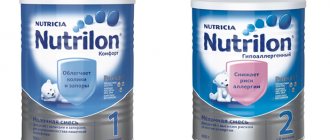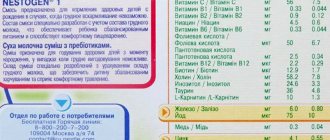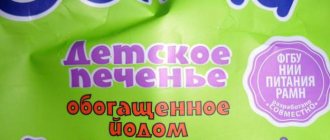presents the “Nan Hypoallergenic” mixture for children from birth.
The main function of this line of nutrition is to reduce the manifestations of various types of allergic reactions , including atopic dermatitis.
Suitable for children with mild food allergies, but not suitable for children with cow protein allergy .
This is not a therapeutic baby food, but a preventive one, it can only be prescribed by a doctor; the mother should not decide to switch to a hypoallergenic formula.
Protein Opti Pro - a component of success
The distinctive component in the Nestlé Hypoallergenic baby food formula is a special protein called Opti Pro .
Protein is generally the most important component of nutrition for a child of the first year of life.
It plays a role literally everywhere - in the formation of the skeleton, brain, muscles and tissues. The child’s tendency to allergies in the first few years of life depends on what protein is present in a child’s diet.
Whole cow's milk is a difficult food for children under three years of age to digest and can cause digestive problems in the child; in addition, store-bought milk does not contain probiotics and lacks beneficial bacteria.
That's why Nestlé created the Opti Pro protein. Its peculiarity is that it is in a partially hydrolyzed, that is, split state .
It is this property that makes Nan Hypoallergenic food suitable for children with mild forms of allergies, because partially digested protein is much easier for children’s tummies to digest.
Cooking time
The mixture dissolves easily and quickly in water. It does not form lumps, which means the baby will be comfortable. The preparation itself also does not take much time: just dissolve one measuring spoon in warm boiled water, shake the bottle - and the delicious dish is ready! It’s simple, even a very young mother can cope with this task. The main requirement here, perhaps, is the quality of water: you cannot add raw water taken from the tap, too hot or cold.
Many parents note that the baby does not have constipation, and there is always an excellent appetite for this mixture. There is also a separate place to store a spoon, which is also very convenient. There is no need to handle the dry mixture with your hands and then prepare it for your baby.
Composition "Nan hypoallergenic"
In addition to the special protein, “Nan Hypoallergenic” contains the following useful components:
- Probiotics in the form of bacteria B. Longum and L. Rhamnosus - they play a big role in the development and functioning of the baby’s immune system.
- Polyunsaturated acids Omega-3 and Omega-6 . They are also present in breast milk, their main role is the formation of the brain and vision of the newborn.
- A complex of vegetable oils , including sunflower, coconut, low-erucate rapeseed, palm, and Mortierella Alpina oil.
- Lactose and cow's milk proteins.
- Maltodextrin as a thickener.
- Fish fat.
Baby food "Nan GA" is available in tin cans; the line contains three types of mixture, depending on the age of the child.
How to properly dilute the mixture and introduce it into complementary foods
“NAN”1 and “NAN”2 are adapted infant formulas, and “NAN” 3 and “NAN” 4 are dry milk drinks for feeding children. The main difference between them is the reduced protein content in the adapted mixtures due to a significant amount of demineralized whey. In dairy drinks, the required protein balance is achieved through skim milk and whey protein.
40 as for a woman's mature breast milk. This protein is called OPTIPRO. It allows you to reduce the metabolic load and ensure a reduction in the risk of obesity in the future due to the correct ratio of proteins and maintaining the necessary balance of amino acids. The time-prolonged effect of nutrition in early childhood on metabolic characteristics in adulthood is now increasingly confirmed, and in this light, the OPTIPRO protein looks very convincing.
“NAN”1 and “NAN”2 are adapted infant formulas, and “NAN” 3 and “NAN” 4 are dry milk drinks for feeding children. The main difference between them is the reduced protein content in the adapted mixtures due to a significant amount of demineralized whey. In dairy drinks, the required protein balance is achieved through skim milk and whey protein.
40 as for a woman's mature breast milk. This protein is called OPTIPRO. It allows you to reduce the metabolic load and ensure a reduction in the risk of obesity in the future due to the correct ratio of proteins and maintaining the necessary balance of amino acids. The time-prolonged effect of nutrition in early childhood on metabolic characteristics in adulthood is now increasingly confirmed, and in this light, the OPTIPRO protein looks very convincing.
How much formula to give your baby per feeding depends on his age. The dosage can be found in the feeding table, which is available on each package. But in general, it is enough to remember the main rule from the instructions for use: mix one measuring spoon of powder in 30 ml of water.
The cooking method is very simple:
- Wash the bottle and pacifier.
- Add the required amount of milk powder using a level measuring spoon.
- Pour boiled water heated to 37 C (temperatures above this level inhibit the beneficial properties of prebiotics).
- Shake the bottle until the powder dissolves.
It is important to know how to dilute the mixture correctly. If you vigorously shake the bottle from bottom to top, as almost all parents like to do, air bubbles will form.
If you do not wait until the foam settles, air will enter the baby’s digestive tract, which will cause colic and bloating.
Therefore, you need to mix the mixture carefully, in a circular motion.
NAN Hypoallergenic 1 OPTIPRO HA
For babies from birth to six months.
This food contains more lactose than all other formulas in the line under review. It's 7.83 grams here.
The main components of nutrition include proteins, fats and carbohydrates.
Of the fatty acids, the composition “Nan GA 1” contains linoleic (0.54 g) and alphalinoleic (65.40 mg) acids, as well as arachidonic and decosohexaenoic acids in equal amounts of 7.8 mg each.
The osmolality of the mixture is 320 mOsm.
Formulas for sensitive children
Recently, baby food manufacturers have been offering a wide selection of milk formulas for children with digestive problems and allergic reactions.
You can replace unsuitable milk with a hypoallergenic option. Here, with the help of innovative technologies, cow protein undergoes a number of changes and no longer causes irritation to the gastrointestinal tract. Doctors usually suggest trying such mixtures in children with mild manifestations of food intolerance.
However, it is necessary to monitor the child’s health, since many pediatricians note the insufficient effectiveness of hypoallergenic mixtures in preventing a reaction to animal protein.
- An excellent option for solving a nutrition problem may be NAN fermented milk 1 after an allergy. It also contains bifidobacteria, which help restore microflora and improve intestinal function in children who are forced to undergo antibiotic therapy. Parents note the disappearance of constipation and digestive disorders with the introduction of mixtures with lactic acid bacteria.
- If replacing with fermented milk mixture also did not help the baby, there is another option - lactose-free nutrition. Maltodexin in this milk prevents the appearance of loose stools. Other components of the mixture help restore microflora, remove inflammatory processes in the intestines and improve the baby’s body’s resistance to infections.
Whatever mixture you choose to feed your baby, you must carefully follow all the recommendations for its preparation specified by the manufacturer. You cannot store milk for a long time that the baby has not finished. Reheating the finished mixture is also strictly prohibited. It should always be fresh. Otherwise, a fermentation process may begin already in the bottle, which will cause various eating disorders.
In addition, it is necessary to thoroughly rinse the bottle and nipple from any remaining mixture and rinse everything with boiling water to remove pathogenic microbes. This should be done after every feeding, even at night. If you follow all the rules of hygiene and monitor the quality of your baby’s diet, you will less often have to worry about problems with the functioning of the baby’s gastrointestinal tract.
Video on the topic of the article:
NAN Hypoallergenic 2 OPTIPRO HA
For children already receiving their first complementary foods - from six months to one year .
This type of mixture contains less lactose than the previous one - already 4.95g.
The amount of protein here is the same as in “Nan GA 1”, there is less fat - 3.08 g, more carbohydrates - 8.54 g.
Fatty acids are also present here, however, in smaller quantities.
Feed osmolality 264 mOsm/kg.
NAN Hypoallergenic 3
For children over one year old.
This food contains the most protein - 2 g and the least fat - 3 g and carbohydrates - 7.8 g.
The lactose content here is less than in “Nan GA 1” and “Nan GA 2” - 4.9 g.
The composition "Nan hypoallergenic 3" also contains less fatty acids.
Osmolality 270 mOsm/kg.
Advantages and disadvantages
In my practice, there were children for whom this milk substitute worked well.
Example: The child received Nutrilon comfort from 1 month. After 2 weeks of using the product, the baby developed a rash on his face. Mom independently decided to change the formula to NAN hypoallergenic. After 7 days of using NAN milk replacer, the baby's allergy symptoms disappeared. The baby ate well and had normal stools.
Many mothers have complained that there is no difference when using NAN GA and NAN optipro (regular). If the reaction was to a simple mixture, then the hypoallergenic one was also preserved. This can be explained by the fact that NAN optipro and hypoallergenic have an identical protein composition with a partially hydrolyzed structure.
Comparison of the composition “Nan hypoallergenic 1, 2, 3”
What are the special differences between these three mixtures and what are their similarities?
The composition “Nan hypoallergenic 1” contains more fats, carbohydrates, lactose, arachidonic and decosohexaenoic acids.
It also contains taurine, carnitine, and nucleotides that are missing in subsequent mixtures.
The composition of “Nan Hypoallergenic 2” includes the maximum amount of carbohydrates - 8.54 g, as well as the most chlorides and manganese, selenium and iodine.
The composition “Nan hypoallergenic 3” contains a lot of proteins (2g) and fats (3g), but less than the other two lactose mixtures - 4.9g.
The amount of arachidonic and decosohexaenoic acids is the least here - 4.3 g each.
This mixture also contains probiotics.
“Nan GA 3” contains more sodium, potassium, calcium, magnesium, selenium, and iodine than previous mixtures.
The osmolality of mixtures No. 2 and No. 3 is almost the same, it is much lower than the maximum permissible limits and this is good - 264 and 270 mOsm/kg.
How does an allergy to formula manifest in an infant?
An infant's allergy to infant formula may appear almost immediately after consumption (1.5-2 hours) or may make itself felt much later.
Symptoms of an allergy to the consumed formula in an infant may manifest itself as follows:
- A rash appears on the skin of the face, neck, buttocks and legs, as well as erythema, itching, dryness and peeling.
- There is a nonproductive cough, nasal congestion, and watery discharge, but without low-grade fever or fever.
- Negative reactions from the digestive tract. Frequent regurgitation of air or mixture and severe hiccups appear. Vomiting, diarrhea, or constipation may also occur.
If a bacterial infection occurs, the body temperature may rise. The skin of a baby is characterized by looseness and a tendency to generalize the pathological process, therefore, against the background of a decrease in the protective properties of the skin, the peculiarities of its structure and uncontrolled scratching of rashes, pyoderma (purulent skin lesions) occurs, which can cause an increase in body temperature.
All of the listed symptoms may indicate other diseases or pathological conditions, so the diagnosis should only be confirmed by a doctor.











